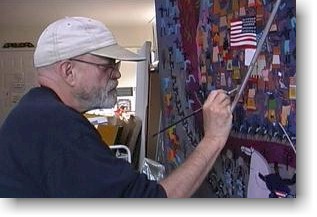
|
Allan Mardon, a graduate of the Ontario College of Art in Toronto, completed postgraduate study at Edinburgh School of Art in Scotland and the Slade School of Fine Art, University of London. He designed graphics for CBC Television and served as an animator for the National Film Board of Canada. In 1964, he emigrated to the United States where he enjoyed a long and successful career in commercial illustration before moving to Tucson in 1989 to pursue a career in fine art. After moving to the Southwest, Mardon became inspired by the graphic beauty and history of his new surroundings and began to approach his canvas in an entirely different way, embarking upon a series of paintings with Native American themes. Employing a primitive and narrative style, these works depict in historic detail the artifacts and beauty of indigenous cultures of bygone times. As avid collectors Dan and Sue Frost recently wrote, “Allan Mardon is a rare artist who combines highly sophisticated technical training and techniques, a deep understanding of Indian culture and a creative avant-garde outlook and style that transform traditional Western art into an entirely new form and texture.” “Traditional Western artists are stuck in a freeze frame of one historical event,” says Kenneth L. Schuster, director of the Bradford Brinton Memorial (Big Horn, WY), a museum dedicated to Western art that featured a summer-long one-man show of Mardon’s work beginning in May 1998. “But Mardon breaks with this Charles Russell-Frederic Remington tradition. His work is both modern, in that he brings a new viewpoint to the traditional form of Western art, and classic in the way he reverts to the way artists of centuries past presented a scene in many vignettes. This makes his work intricate and exciting, with nothing sentimental or romantic in it. Because Western art, as traditionally rendered, is undergoing a significant change, I believe he is setting the new trend in that genre,” says Schuster. Jeff Mitchell, owner of Mitchell/Brown Fine Art in Santa Fe agrees. “Mardon’s paintings have a pulse,” he says. “You can view them repeatedly and always find new life and new perspective in their stories. The paintings of Allan Mardon are highly sophisticated and personal interpretations of historic events. For me, not only are his pieces reminiscent of American Indian ledger hide, shield and teepee painting, the complex compositions, often with figures floating in all directions, recall ancient rock art. Masterful in color and design, Mardon’s fresh and exciting paintings are unlike any other contemporary works I have seen.” Mardon’s paintings can be found in galleries and museums throughout the country as well as extensive public, corporate and private collections in the United States and abroad. The Battle of Greasy Grass, Mardon’s highly-acclaimed and complicated, large-scale (11.5’x6.5') painting of the Custer Battle, has been the centerpiece of an exhibition at the Whitney Gallery of Western Art, Buffalo Bill Historical Center, in Cody, WY, since March, 1999. It has also been featured in several magazines, including most recently Montana’s Big Sky Journal. |